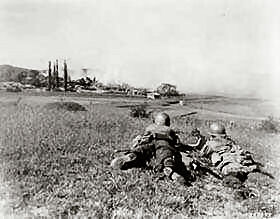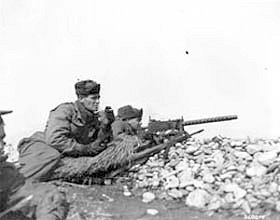At 41 lbs for gun and tripod, the M1919A4 was much lighter than the water-cooled M1917A1 (93 lbs for gun and tripod). On the other hand, the air-cooled weapon was unable to maintain the same level of sustained fire as the water-cooled M1917A1, and did not have the steadiness of accuracy as the heavier weapon. Also, some combat units criticized the A4 as being too slow to get into action, and that the crew was too vulnerable.
The result was M1919A6, which featured a detachable shoulder stock, folding bipod, carrying handle, and a lighter barrel than the A4. The M1919A6 was really an attempt to fill the firepower gap between the BAR and the M1919A4 with an LMG but many troops felt the result was less-than-satisfactory. Light support machine guns were certainly very good and useful weapons, but they could often put soldiers at a firepower disadvantage while in a firefight where the enemy was supported by the 7.92mm24 Chinese Heavy MG. Still, although only 43,500 A6's were produced in WWII, compared to 390,000 A4s, and although the A6 was even less steady in sustained fire than the A4, some experts argue that the A6 was the most unique weapon in the M1919 series.
The M1919A6 did see much service in Korea, and later in Vietnam.
The Chinese captured many of our machine guns during the first 6 months after their entry into the war. Here they use an A6 in one of their forward positions. Note the camouflage to conceal them from air attack.








